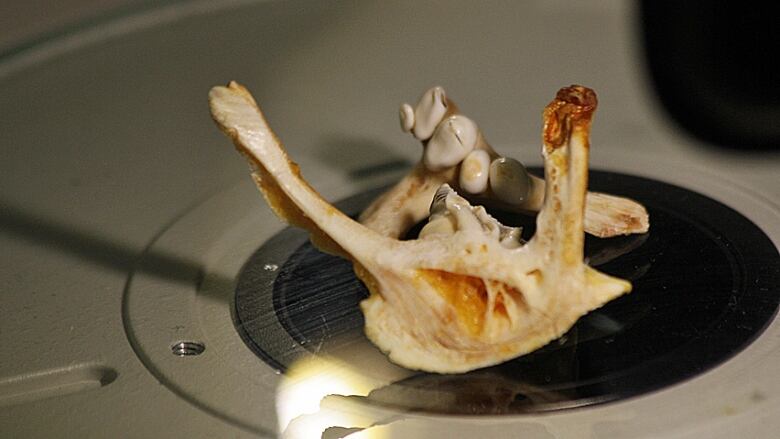Dreaded Asian Carp the target of new Ontario lab
Burlington-based lab allows Canada to push back against imminent invasive species threat, researchers say

Canada has a new tool to battle the spread of an insatiable invasive species: an Asian carp research lab thats the first of its kind in the country.
Researchers say the Burlington, Ont.-based lab at the Canada Centre for Inland Waters (CCIW) will be an integral part of the battle against a fish that threatens to decimate food sources for native species in North America. The facility was formally unveiled Monday.
Right now, the Great Lakes are absolutely at risk, said Becky Cudmore, the Asian carp program manager at the CCIW. Canada as a whole is in danger, but the Great Lakes are at an imminent risk.
- RELATED: Hamilton loses over 20 top environmental scientists
- RELATED: Asian carp could survive in all Great Lakes, scientists say
Weve worked hard to tackle this issue head on.- Minister Diane Finley
Bighead and silver carp are largely considered to be the worst part of that risk, as they eat huge amounts of plankton, which is the foundation of aquatic food chains. They have infested much of the Mississippi River basin and are threatening to gain a foothold in the Great Lakes through rivers and canals. If that happens, species native to Canada could be wiped out.
Diane Finley, the minister of public works and government services, told reporters at a press conference Monday that Asian carp could have a devastating effect if left unchecked.
But weve worked hard to tackle this issue head on, Finley said. [This lab] will dramatically strengthen our ability to respond.
Finding carp was 'shocking': researcher
With this facility in place, researchers can now test water and fishsamples found in Canada, rather than shipping them to the U.S. for analysis. That means scientists can get test results back in days or weeks, which saves both time and money.
Employees from the new facility will also conduct inspections of high-risk waterways starting this summer. Those inspections arent coming a day too soon last year, Fisheries and Oceans Canada confirmed two separate captures of live grass carp near Dunnville, Ont., in the Grand River near Lake Erie.

Aquatic science biologist David Marson says he knew exactly what was in his nets when he pulled them up that day. It was unexpected, he said. It was shocking, right off the bat. But it was also reassuring to know our gear was working.
Luckily, those carp were sterile, and not able to reproduce. Scientifically sterilized carp can be used to quickly wipe out nuisance underwater plant species, as carp dont eat other fish and devour up to 120 per cent of their own body weight each day. But if fertile carp ever made it into Canadian waters, wed have a massive problem on our hands. Government models show it would only take 10 male and ten female carp to ensure the species grabs a foothold.
These guys are excellent invaders and survivors, Cudmore says. They outpace our native species.
Fish freed by flooding
Forty-five grass carp have been recorded as caught in the Great Lakes basin between 2007 and 2012. Some were found in Lake Erie, others in tributaries of the lakes.
About half of those caught in that time could reproduce, which could mean the lakes already have a breeding population, according to a paper published online in March by the Canadian Journal of Fisheries and Aquatic Sciences.

Asian carp first started showing up in North America in the 70s, when they were brought in for the aquaculture industry in the U.S. and for the live food fish industry in Canada. Researchers believe flooding in the southern U.S. let the carp move from their contained environments and into open waters.
A hurdle to keeping the carp out of the Great Lakes is the patchwork quilt of policies and regulations. Unlike bighead and silver carp, they are not illegal to possess under federal law. The fish is banned in Michigan and Minnesota, and in Wisconsin, they can be used only for research. But the five other Great Lakes states Illinois, Indiana, Ohio, Pennsylvania and New York allow their use with special permits.
There are four staff members and 15 summer students out in boats right now on Lake Huron and Lake Ontario searching for carp species, Cudmore says. They dredge areas with nets and also use electrofishing boats which send an electric current into the water that stuns the fish, so they can be scooped off the surface and tested.
$400K in funding
The federal government has allocated $400,000 to the construction of the lab, which was part of a $17.5 million funding announcement from 2012. Five full-time research jobs and a number of short term positions and summer students, have been added from this funding, Finley says. That slightly bolsters the ranks at a government institution that has endured a wave of government cutbacks in the last three years.
The most recent figures from the Professional Institute of the Public Service of Canada (PIPSC) shows that as of the start of 2014 there were only 33 Environment Canada and seven research scientists from the Department of Fisheries and oceans working at the high-tech lab. In 2010, there were 63 research scientists at the facility.
In 2000, the two organizations kept a combined 58 researchers at the site.
Watch: Asian carp jumping on the Wabash River near Montezuma, In.:
With files from The Associated Press












_(720p).jpg)


 OFFICIAL HD MUSIC VIDEO.jpg)
.jpg)



























































































